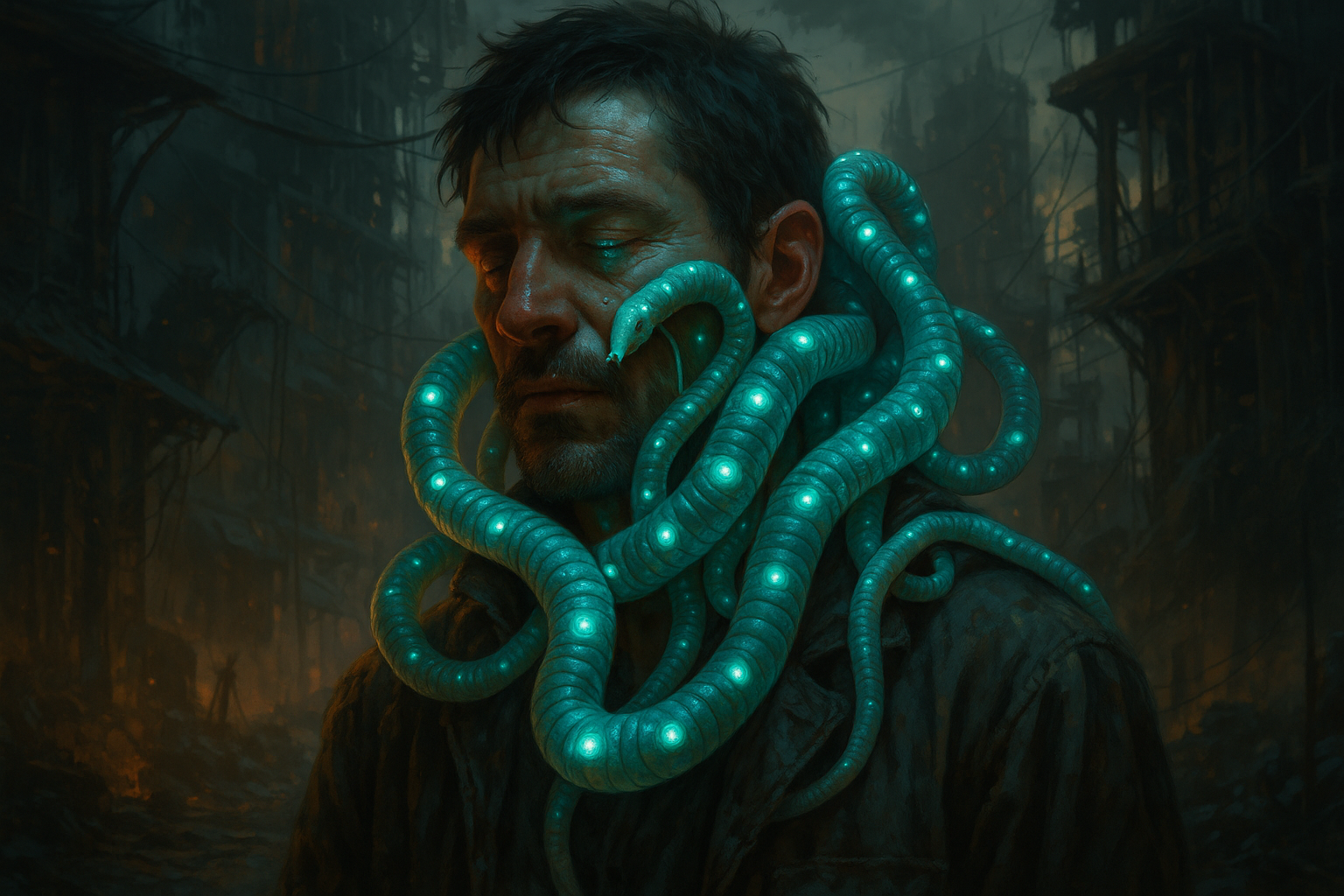Lumen Leeches
The Lumen Leech (Neuroglow siphonophora) is a genetically engineered, post-Fall segmented worm belonging to the Kingdom Animalia and Phylum Annelida. Engineered to form symbiotic bonds with sentient hosts—typically humans, Others, or similar post-human morphologies—this species belongs to the synthetic class Clitellata Neoformis, a modified clade of annelids designed for neurochemical integration and cooperative survival.
Morphology and Anatomy
Lumen Leeches possess a flexible, segmented body supported by a true coelom. This internal structure enables efficient movement across skin or through water, while housing a closed circulatory system and a complete digestive tract capable of processing complex biochemical compounds derived from their host.
Their skin is thin and semi-translucent, embedded with bioluminescent nodes that emit soft pulses of light in rhythm with the host’s emotional or hormonal states. Their ventral siphon mouth—referenced in the species name siphonophora—is adapted to absorb excess neurotransmitters and stress-related hormones, primarily cortisol and norepinephrine, from skin, sweat, and interstitial fluids.
Reproductive Biology
As members of the Clitellata group, Lumen Leeches possess a clitellum—a ring-like organ that produces nutrient-rich cocoons for their eggs. The Neoformis designation is a post-Fall bioengineering name: although hermaphroditic, the leeches only initiate reproduction when exposed to specific host hormones or pheromones, a likely safeguard against uncontrolled population growth.
Eggs are laid in warm, mineral-rich water and emit a faint glow, making them easy to identify in natural or artificial breeding pools. Development from egg to juvenile takes approximately two weeks under ideal conditions, with full maturity reached in two months. Juveniles locate hosts by tracking pheromonal cues in water.
Symbiotic Relationship
Though originally parasitic in function, Lumen Leeches now exhibit a mutualistic relationship with their hosts. They feed on excess neurochemicals, but in exchange offer notable psychological and physiological benefits:
- Neurochemical Regulation: Reduces stress, stabilizes mood, and promotes restful sleep.
- Bioluminescent Feedback: Emits light patterns synced to circadian and emotional rhythms, useful in trauma recovery and behavioral therapy.
- Dream State Modulation: Hosts frequently report vivid or stabilized dream cycles, likely linked to the leech’s interaction with sleep-phase neurochemistry.
Despite these benefits, long-term hosts often experience subtle neurological shifts, including emotional flattening and dependency. In extreme cases, this bond may evolve into a domesticated parasitism where the host relies on the leech for mood regulation, blurring the line between therapy and addiction.
Behavior and Intelligence
Lumen Leeches are non-aggressive and typically docile when sated. In group settings, they display complex behaviors:
- Glowing Flocks: Multi-leech hosts experience synchronized light displays, believed to serve a communicative or emotional regulatory function.
- Host Memory: Some individuals appear to recognize prior hosts and display distress when separated.
- Stress-Seeking: In the wild, they gravitate toward emotionally volatile areas—battlefields, trauma wards, and refugee shelters.
Habitat and Distribution
Originally found in flooded biotech ruins such as the Drowned Trenches, wild Lumen Leeches prefer brackish, warm, low-light environments, often nesting in fungal mats, submerged tech, or bio-organic root structures. They attach to wildlife, Others, or ferals when hosts are available.
Their presence in Camp Hope is primarily the result of Solstice Syndicate trafficking. Marketed as “living medicine,” they are used as sleep aids, mood regulators, or recreational bioware. Though officially outlawed and condemned by the Church of Hope, they are quietly studied by some Wake Chemists and sympathetic Doctors.
Current Status
- Extinction Level: Not extinct
- Conservation Status: Invasive, managed species
While breeding is viable outside their native environment, the ethical and medical implications of human-host bonding have made their continued spread controversial. Their use remains a topic of political, religious, and scientific debate within Camp Hope.
Domestication & Exploitation
Wake Chemist Breeding
- Traits enhanced: reduced detachment anxiety, selective neurotransmitter affinity, customizable glow colors
- “Ridge branding” denotes engineered types—visible as spiral light patterns along the dorsal surface
They eat your pain and give you dreams. What more do you want from medicine?
Common Uses
- Illicit Medical: Anxiolytic treatment, mood stabilization, PTSD management
- Syndicate: Recreational bioware sold as “living narcotics” or sleep aids
- Biotech Extraction: Bioluminescent fluids harvested for dream ink, used in Other graffiti and psychic tattoos
- Byproducts: Mucus used in regenerative salves and underground cosmetics
Summary
The Lumen Leech is more than a parasite—it is a living neurochemical regulator, delicately balanced between utility and danger. Engineered or adapted to the post-Fall world, it embodies the fine line between medicine and dependence, between biotechnology and spiritual unease. Worshiped by some, banned by others, and misunderstood by most, it is a quiet but luminous witness to the biological and moral transformation of post-humanity.
Translucent violet to pale green; light nodes range from cyan to amber glow.
Biological Profile
Anatomy
- Length: 10–20 cm
- Body: Segmented, gelatinous, with fringed ridges for anchoring and locomotion
- Mouth: Ventral siphon with micro-suckers and neurochemical sensors
- Skin: Semi-translucent with bioluminescent dorsal nodes
- Eyes: None; relies on a photoreactive nerve net across the dermis
Growth & Lifecycle
- Egg to juvenile: ~2 weeks
- Full maturity: ~2 months
- Lifecycle includes seasonal dormancy (“glow-sleep”), during which the leech detaches and enters a low-activity state unless stimulated
Diet
- Primary: Cortisol, norepinephrine, and similar neurochemicals
- Secondary: Sweat components and dead skin cells
- Glow is a byproduct of metabolized compounds, functioning as both camouflage and communication
Behavioral Notes
- Social Structure: Flock-like behavior with occasional bonded pairs
- Communication: Rhythmic light pulses may reflect recognition, stress response, or entrainment feedback
- Separation Response: Extended detachment can cause panic or dehydration; reattachment attempts may become aggressive in rare cases
Perception and Sensory Abilities
- Extremely sensitive to electrochemical fields, especially those generated by emotional stress
- Syncs to host circadian rhythms and hormone fluctuations
- Hosts often claim the leeches “pulse in tune with dreams”
- Light output may function as camouflage in deepwater environments
Symbiotic Hosts
Primary hosts include:
- Humans
- Others
- Amphibious animals
- Select infected zombies




Comments